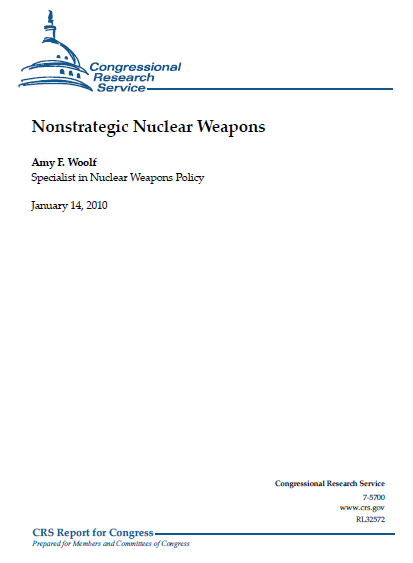 CRS Report
CRS Report
- RL32572
- Amy F. Woolf, Specialist in Nuclear Weapons Policy
- 31 pages
- January 14, 2010
During the Cold War, the United States and Soviet Union both deployed thousands of
“nonstrategic” nuclear weapons that were intended to be used in support of troops in the field during a conflict. These included nuclear mines; artillery; short, medium, and long-range ballistic missiles; cruise missiles; and gravity bombs. In contrast with the longer-range “strategic” nuclear weapons, these weapons had a lower profile in policy debates and arms control negotiations. At the end of the 1980s, before the demise of the Soviet Union, each nation still had thousands of these weapons deployed with their troops in the field, aboard naval vessels, and on aircraft. In 1991, both the United States and Soviet Union announced that they would withdraw most and eliminate many of their nonstrategic nuclear weapons. The United States now retains approximately 1,100 nonstrategic nuclear weapons, with a few hundred deployed with aircraft in Europe and the remaining stored in the United States. Estimates vary, but experts believe Russia still has between 2,000 and 6,000 warheads for nonstrategic nuclear weapons in its arsenal. The
Bush Administration indicated that nuclear weapons remained essential to U.S. national security
interests, but it did quietly redeploy and remove some of the nuclear weapons deployed in
Europe. In addition, Russia has increased its reliance on nuclear weapons in its national security
concept. Some analysts argue that Russia has backed away from its commitments from 1991 and
may develop and deploy new types of nonstrategic nuclear weapons.Analysts have identified a number of issues with the continued deployment of U.S. and Russian
nonstrategic nuclear weapons. These include questions about the safety and security of Russia’s
weapons and the possibility that some might be lost, stolen, or sold to another nation or group;
questions about the role of these weapons in U.S. and Russian security policy, and the likelihood
that either nation might use these weapons in a regional contingency with a non-nuclear nation;
questions about the role that these weapons play in NATO policy and whether there is a
continuing need for the United States to deploy these weapons at bases overseas; and questions
about the relationship between nonstrategic nuclear weapons and U.S. nonproliferation policy,
particularly whether a U.S. policy that views these weapons as a militarily useful tool might
encourage other nations to acquire their own nuclear weapons, or at least complicate U.S. policy
to discourage such acquisition.Some argue that these weapons do not create any problems and the United States should not alter
its policy. Others, however, argue that the United States should reduce its reliance on these
weapons and encourage Russia to do the same. Many have suggested that the United States and
Russia expand efforts to cooperate on ensuring the safe and secure storage and elimination of
these weapons, possibly by negotiating an arms control treaty that would limit these weapons and
allow for increased transparency in monitoring their deployment and elimination. Others have
suggested that any potential new U.S.-Russian arms control treaty count both strategic and
nonstrategic nuclear weapons. This might encourage reductions or the elimination of these
weapons. The 111th Congress may review some of these proposals.…
The Distinction Between Strategic and Nonstrategic Nuclear Weapons
The distinction between strategic and nonstrategic (also known as tactical) nuclear weapons
reflects the military definitions of, on the one hand, a strategic mission and, on the other hand, the
tactical use of nuclear weapons. According to the Department of Defense Dictionary of Military
Terms,6 a strategic mission is:Directed against one or more of a selected series of enemy targets with the purpose of
progressive destruction and disintegration of the enemy’s warmaking capacity and will to
make war. Targets include key manufacturing systems, sources of raw material, critical
material, stockpiles, power systems, transportation systems, communication facilities, and
other such target systems. As opposed to tactical operations, strategic operations are
designed to have a long-range rather than immediate effect on the enemy and its military
forces.
In contrast, the tactical use of nuclear weapons is defined as “the use of nuclear weapons by land,
sea, or air forces against opposing forces, supporting installations or facilities, in support of
operations that contribute to the accomplishment of a military mission of limited scope, or in
support of the military commander’s scheme of maneuver, usually limited to the area of military
operations.”
